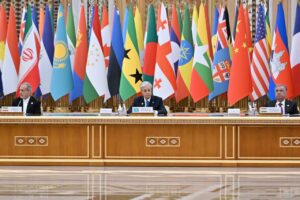Unlocking Eurasia’s Economic Potential: The Strategic Significance of the Middle Corridor

As leaders from across the globe converge for the Shanghai Cooperation Organization (SCO) summit on July 4th, the spotlight is sharply focused on enhancing regional connectivity and fostering economic cooperation. Against this backdrop, the recent developments in Sino-Kazakh relations, particularly highlighted during Chinese President Xi Jinping’s visit to Kazakhstan, underscore the profound impact of the Middle Corridor on Eurasian trade dynamics.
President Kassym-Jomart Tokayev’s warm welcome to President Xi Jinping in Kazakhstan symbolizes more than diplomatic pleasantries; it signifies a robust partnership underpinned by shared economic interests and strategic collaboration. The bilateral trade turnover between Kazakhstan and China surpassing $41 billion last year underscores the growing economic interdependence between these two nations. This economic synergy is further cemented by 45 ongoing investment projects totaling $14.5 billion across critical sectors such as industry, energy, transport, green economy, and agriculture.
Central to this burgeoning partnership is the Middle Corridor, a transformative initiative that revitalizes the ancient Silk Road routes. This multimodal transport infrastructure links China’s extensive rail network with the European Union via Central Asia, the Caucasus, Turkey, and Eastern Europe. The corridor’s strategic importance lies not only in its ability to significantly reduce transit times—cargo from China to Europe in just 20–25 days—but also in enhancing regional connectivity and economic integration.
The inauguration of cultural centers and educational institutions like the Beijing University of Language and Culture branch in Astana underscores the cultural and educational dimensions of Sino-Kazakh relations. These initiatives promote people-to-people exchanges and foster mutual understanding, essential pillars for long-term diplomatic and economic cooperation.
At the SCO summit, where leaders including Russian President Vladimir Putin and Pakistani Prime Minister Shehbaz Sharif are gathering, the discussion is expected to revolve around deepening regional cooperation amidst global uncertainties. The Middle Corridor emerges as a pivotal initiative that not only strengthens bilateral ties but also enhances SCO’s mandate of promoting stability and prosperity across Eurasia.
For Pakistan, as a vital SCO member and participant in regional economic frameworks, the Middle Corridor presents opportunities for enhanced connectivity and economic diversification. Collaborative efforts within SCO can leverage this corridor to bolster trade links, improve infrastructure, and stimulate economic growth across member states. With 68% of its population comprising youth, Pakistan can harness this demographic dividend by fostering talent development aligned with the opportunities presented by the Middle Corridor. The corridor can become a catalyst for job creation and skill development, particularly in fields like logistics, technology, and trade.
The strategic alignment of the Middle Corridor with broader regional and global economic strategies is evident. By facilitating efficient trade routes and reducing logistical barriers, the corridor fosters a conducive environment for increased economic activity and investment. This is particularly pertinent as Eurasian countries seek to recover and rebuild post-pandemic, harnessing the potential of cross-border cooperation and infrastructure development.
Furthermore, the Middle Corridor aligns with the Sustainable Development Goals (SDGs) by promoting economic growth (SDG 8), industry, innovation, and infrastructure (SDG 9), and partnerships for the goals (SDG 17). The corridor’s emphasis on green economy projects also supports SDG 13, which focuses on climate action. By integrating sustainable practices into infrastructure development, the Middle Corridor not only enhances economic connectivity but also contributes to environmental sustainability.
In this context, the role of business development in the green hydrogen sector, as highlighted by initiatives within the Middle Corridor, becomes crucial. The focus on green economy projects within the corridor can drive innovation and sustainable development, positioning Eurasian countries as leaders in the global energy transition. For instance, investment in green hydrogen infrastructure can provide a sustainable energy source, reduce carbon emissions, and create new economic opportunities.
Moreover, the Middle Corridor’s potential extends beyond economic benefits. It can serve as a platform for regional dialogue and cooperation, addressing common challenges such as climate change, security, and sustainable development. By fostering collaboration among countries with diverse cultural and economic backgrounds, the corridor can enhance mutual understanding and trust, contributing to regional stability and peace.
Looking ahead, as global dynamics evolve, initiatives like the Middle Corridor will play an increasingly crucial role in shaping Eurasia’s economic landscape. By integrating diverse economies and fostering sustainable development, this initiative exemplifies the spirit of international cooperation and mutual benefit—a cornerstone of SCO’s mission and vision for a prosperous Eurasian future.
For Pakistan, leveraging the Middle Corridor’s potential can significantly contribute to its economic growth and development goals. By participating in regional infrastructure projects and enhancing trade links, Pakistan can position itself as a key player in Eurasian trade and logistics. Additionally, by focusing on talent development and aligning with the corridor’s opportunities, Pakistan can harness its youthful population to drive innovation and economic growth.
The Middle Corridor stands as a testament to the transformative power of infrastructure investments and strategic partnerships in unlocking Eurasia’s economic potential. As leaders convene at the SCO summit, the focus on harnessing regional connectivity through initiatives like the Middle Corridor reaffirms the commitment to building a more integrated and prosperous Eurasia for generations to come. This corridor, by facilitating trade, fostering sustainable development, and enhancing regional cooperation, embodies the vision of a connected, prosperous, and stable Eurasia.
By continuing to invest in and support the Middle Corridor, Eurasian countries can unlock new economic opportunities, promote sustainable development, and foster a more connected and prosperous region. As the world navigates the complexities of the 21st century, the Middle Corridor offers a blueprint for how strategic infrastructure investments and regional cooperation can drive economic growth and stability, benefiting not only the countries along the corridor but also the broader global community.


